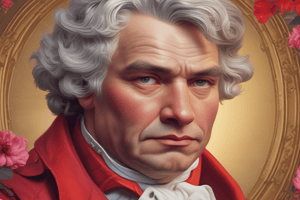Podcast
Questions and Answers
Who was Ludwig van Beethoven?
Who was Ludwig van Beethoven?
A German-born composer who was the most revolutionary musician of the Classical and early Romantic eras.
What is the 'Pathetique' Sonata associated with?
What is the 'Pathetique' Sonata associated with?
- An opera
- A symphony
- Classical Music
- Emotionally deep expression (correct)
What is 'Fidelio'?
What is 'Fidelio'?
Ludwig van Beethoven's only opera.
What was Beethoven's first symphony?
What was Beethoven's first symphony?
What significant change began for Beethoven in 1798?
What significant change began for Beethoven in 1798?
What marked the middle period of Beethoven's life?
What marked the middle period of Beethoven's life?
What does Beethoven's Eroica Symphony deal with?
What does Beethoven's Eroica Symphony deal with?
What is 'Missa Solemnis'?
What is 'Missa Solemnis'?
How many symphonies did Beethoven write?
How many symphonies did Beethoven write?
What is believed about Beethoven's 10th Symphony?
What is believed about Beethoven's 10th Symphony?
What are 'Fur Elise' and 'Moonlight Sonata' examples of?
What are 'Fur Elise' and 'Moonlight Sonata' examples of?
Beethoven increased the number of ________ in the orchestra.
Beethoven increased the number of ________ in the orchestra.
He expanded the dynamic range from _____ to _____.
He expanded the dynamic range from _____ to _____.
The development sections of his compositions were ________, ________, and ________.
The development sections of his compositions were ________, ________, and ________.
In some compositions, he left no pauses between some of the ________.
In some compositions, he left no pauses between some of the ________.
Flashcards are hidden until you start studying
Study Notes
Beethoven's Life and Impact
- Ludwig van Beethoven (1770-1827) was a pivotal figure in transitioning between the Classical and Romantic eras.
- Despite facing complete deafness for much of his career, Beethoven greatly advanced the expressiveness and socio-political influence of music.
- Key achievements include transforming the piano sonata, focusing on emotional depth, structural diversity, and technical complexity beyond predecessors like Haydn and Mozart.
Representative Works of Beethoven
- Symphony No. 3 "Eroica" (1803-1804): Initially dedicated to Napoleon, this piece marked a shift towards program music, emphasizing themes of heroism and foreshadowing the Romantic period.
- "Pathetique" Sonata: Titled in a way that evokes deep emotional expression, signaling a move towards Romanticism in Beethoven's work.
- Fidelio: His only opera, originally classical in form, showcases Beethoven's evolving style.
- Piano Concertos: The Piano Concerto No. 2 was composed before No. 1 but labeled differently due to publication timings, exemplifying his classical roots.
Mid-Career Developments
- Beginning in 1798, Beethoven's gradual loss of hearing led him to deeper introspection and a heightened focus on his musical creations.
- His middle period is characterized by significant works like "Fidelio," with multiple revisions that illustrate his commitment to dramatic structure in opera.
Choral Innovations
- Missa Solemnis: Written around 1819, incorporates sacred themes and complex musical forms learned from earlier composers, showcasing Beethoven's evolving relationship with spirituality and music.
- Symphony No. 9: Premiered in 1824, notably features chorus and solo voices for the first time, including the famous "Ode to Joy." The performance illustrated Beethoven’s profound connection to the audience despite his deafness.
Legacy and Unfinished Works
- Beethoven composed a total of nine symphonies and nine concertos, alongside a rich array of orchestral music.
- He is speculated to have been working on a 10th Symphony during his final years, indicating his relentless creativity until the end.
Romantic Characteristics
- Beethoven’s works demonstrate Romanticism through increased orchestral size, expanded dynamic ranges (ppp to FFF), and lengthy, complex development sections.
- His compositions often feature seamless transitions between movements, a hallmark of the Romantic style.
Iconic Piano Pieces
- Fur Elise and Moonlight Sonata are among the most recognized piano works worldwide, highlighting Beethoven's impact in the Romantic era.
Studying That Suits You
Use AI to generate personalized quizzes and flashcards to suit your learning preferences.




